- Home
- Knitting Terms
Knitting Terms For Beginners
Common Terms Used In Knitting
Knitting terms is a form of knitting language used in patterns just like knitting abbreviations are.
Unlike knitting abbreviations which are more like scrambled up letters and numbers, the terms used in knitting are more like the phrases you'll find in knitting patterns
Sometimes they're just a word but usually it's a short phrase.
Phrases and terms used in knitting are short forms for a specific knitting technique or instruction and they'e very much like knitting abbreviations
I like to think of knitting terms as 'everything else' that knitting abbreviations left out. The knitting terms are what's left.
But for a beginner knitter any way you look at it knitting terms are like knitting abbreviations and something you need to learn and will learn as you go along.
And just like abbreviations, terms are used to shorten a long knitting pattern and not keep repeating the same instructions over and over.

Understanding the phrases and knitting terms will get a lot easier as you go along.
And the more you read patterns and various knitting books you'll find that it all starts to make more sense and eventually you won't even give it another thought.
Below is a basic list of common knitting terms and definitions to help you get started; and I will continue to add too as I go along.
Even in knitting there's always new knitting phrases and terms, or technique that seems to pop up but you'll learn them as you go along.
I've also added pictures wherever possible to help you understand.
I am a participant in the Amazon Services LLC Associates Program, an affiliate advertising program designed to provide a means for sites to earn fees by advertising and linking to Amazon.com and affiliated sites. If you make a purchase through one of my links I may receive a small commission. This will not affect the purchase price and you will not pay more when you buy through my link.
knitting terms and definitions
as established:
Work pattern or series of steps as previously set - in other words you may see something like 'continue working pattern as established'
as if to knit or sometimes knitwise
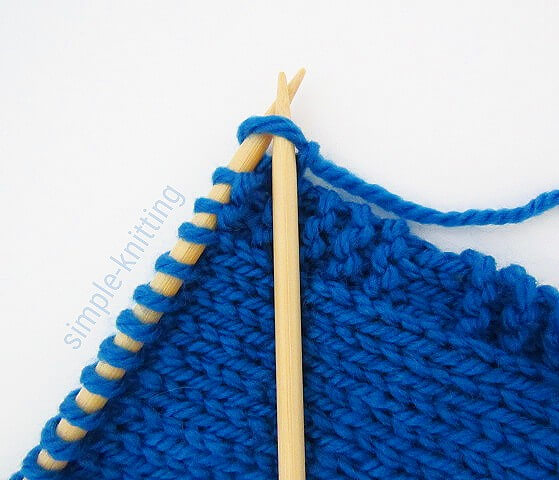 Knitting Term 'as if to knit'
Knitting Term 'as if to knit'Begin knitting next stitch like you're going to knit it, just like in the photo
as if to purl or sometimes purlwise
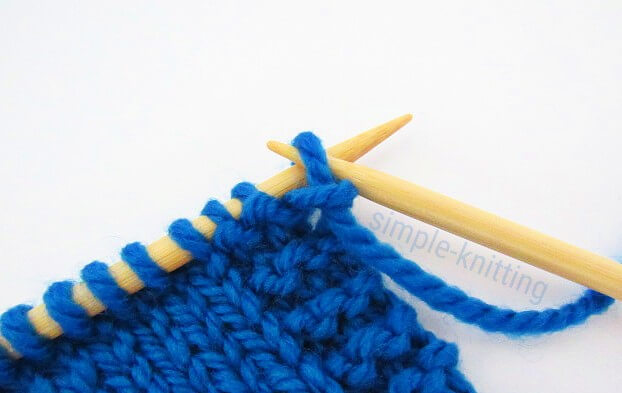 Knitting term 'as if to purl'
Knitting term 'as if to purl'Begin your next stitch as if you're going to purl it. Sometimes they'll say purlwise
at the same time
Sometimes in a knitting pattern you'll need to work more than one set of instructions at the same time.
It might read something like this 'Continue working pattern in Stockinette stitch at the same time continue decreasing stitches every second row'
So you will continue to knit in Stockinette stitch and you will still make your decreases every second row.
ball end of yarn
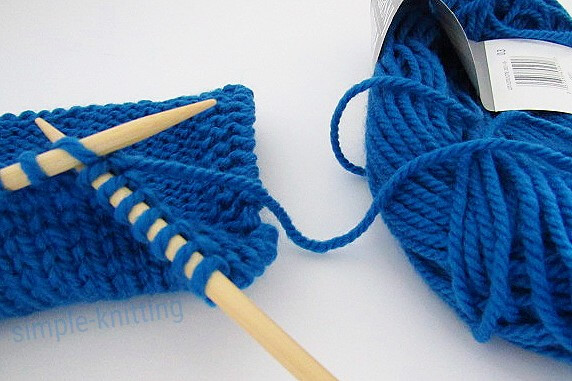 Knitting term 'ball end of yarn'
Knitting term 'ball end of yarn'When you see this term used in knitting it means they're talking about the yarn that runs from your knitting on your needles to the ball of yarn you're using.
front of work
back of work
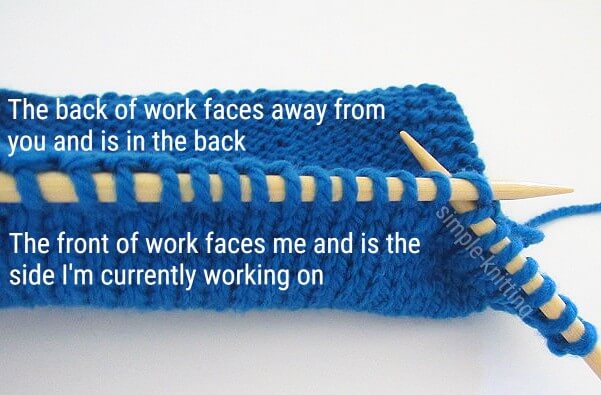 Knitting Term front of work, back of work
Knitting Term front of work, back of workSo just as the photo shows the front of work faces me and is the side currently being worked on.
And the back of work is the side that faces away from you when you are holding the needles just like the photo shows.
Important tip: Keep in mind that it can be either side that is the front of your work depending on which side you're knitting on.
block or blocking
I tend to do blocking when I've used animal fibers like wool, camel and so on.
I don't find it necessary to block with acrylic yarns although there are some people who disagree with me. So the ultimate choice is yours.
Blocking is a finishing technique where you either wet or steam your finished knitted item and gently press the piece into the shape it's supposed to be in.
Blocking helps to set the stitches in the way they're supposed to look. For instance lace knitting involves blocking in order to help define those beautiful lacy stitches.
A heavily textured item will also benefit from blocking to enhance those stitches too.
If you've just finished a knit sweater you will wet the sweater in a special wool detergent like SOAK or Eucalan.
Then you will gently squeeze out excess water, roll it up in a clean towel to get out more water, then lay it out on your blocking mats.
Gently move it into shape and let it dry on the mats. You'll be amazed at how much better it looks once you've set the stitches by blocking.
I'm sure you can find a great youtube video to show you how this procedure is done.
cont in pattern
Continue working pattern as previously established. In other words - keep knitting the way you were originally following the pattern until it says to stop
ending with RS row
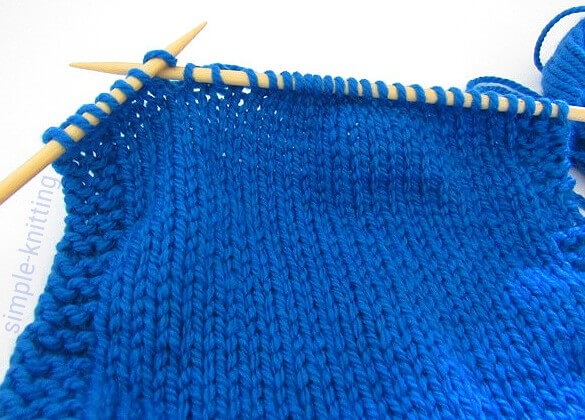 Knitting Term 'ending with RS row
Knitting Term 'ending with RS rowThis term used in knitting means that your last row needs to be a right side row.
You may see something like this: Continue working as established ending with a right side (RS) row.
In the photo above I was just finishing up on the right side row of my swatch.
ending with WS row
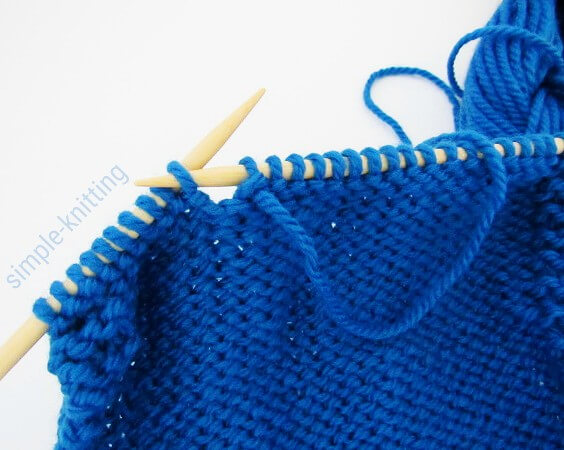 Knitting Term 'ending with WS row'
Knitting Term 'ending with WS row'This term in knitting means that you're last row to work needs to be on the wrong side row.
It may read something like this in a pattern: Continue working as established ending with a wrong side (WS) row.
And just like my photo above, I'm finishing up on the wrong side of my swatch
every other row OR every alternate row
This term used in knitting means to work that specific instruction on alternate rows or every other row (it means the same).
And you may see something like this: Continue increasing stitches every other row OR continue increasing stitches on every alternate row (for a certain amount of rows)
To break this instruction down further you will knit one regular row and then on the next row you'll work an increase or decrease row whichever the instruction is and so on.
frogging
When knitters are frogging their knitting it means that they're unraveling or ripping out their work! So, so frustrating too but we all do it as some point :)
gauge
Knitting gauge is a measurement of how many stitches and rows you get in an inch.
What you need to do is use the yarn you'll be using for your project and you'll knit a gauge swatch in the same stitches as you'll be using in your project
Cast on about 30 stitches and knit a swatch about 4 - 6 inches in length. Then you measure you knitting with a knitting stitch gauge.
I left a link above so you can check out my instructions for how to measure knitting gauge.
join yarn or joining yarn
Join yarn in knitting means adding a new ball of yarn either the same color because you've run out of yarn or you want to add a new color.
Don't worry I have instructions for joining yarn in knitting.
K the knits, P the purls
This is a common term to describe a pattern of knit and purl stitches usually ribbing.
Rather than repeating the pattern over and over they'll say to repeat every row knitting the knit stitches and purling the purl stitches.
I made a tutorial on ribbing stitches that teaches you how to knit the knits and purl the purls.
reverse shaping
This knitting term is often seen in cardigan patterns where the right front and left front are the same only the shaping needls to be reversed.
You see the right side or right front will be shaped for the right side and the left front needs to be shaped for the left front.
What you do is work both fronts identical only you reverse the increases and decreases (the shaping).
If one front was decreasing stitches at the beginning of the row then the other front would be decreasing stitches at the end of the row.
It's just reversed that's all.
right side or RS
Just in case you're not sure the right side (RS) of your work is the public side that people will see
selvage edge or selvedge edge
These are the edge stitches on both sides of your row of kntiting. Sometimes an extra stitch or stitches is added to create a selvedge edge.
By including an extra stitch on both sides of your knitting will sometomes help make seaming the edge easier.
small,(medium, large)
This is a common method of showing changes in knitting patterns for other sizes.
Small is usually first and then continues with other sizes in parentheses. It could also read as follows: 36 (38, 40, 42).
Throughout the pattern you will follow directions for your specific size.
Example: Instructions for size small may be to cast on 60 stitches and for a medium cast on 66 stitches and large 72 stitches so it would look like this: CO 60 (66, 72) sts.
Throughout the pattern you will follow the instructions for your size and the best way to do that is make a copy of your pattern and highlight your size all the way through.
That way you'll be sure to follow the instructions specifically for you size.
tink
Tink is knit spelled backwards and it's the term knitters use if they make a mistake. It means unknitting.
If you make a mistake that isn't too far from where you are currently knitting you can tink back to the mistake and start again.
It's not usually used if you have to go back many rows though. (In all honesty though, I've done it - and it's not fun...haha) Here's a tinking knitting tutorial.
work even
Continue knitting without making any increases or decreases.
wrap and turn
Wrap and turn is also known as short rows. Short rows are a way to shape knitting.
This involves knitting part way across a row, then turning back without finishing the whole row.
This technique is very popular in knitting socks when you create the heel of a sock by using short rows to shape it
The actual 'wrap and turn' is the technique to prevent holes when you turn back without finishing the row.
yarn end or yarn ends
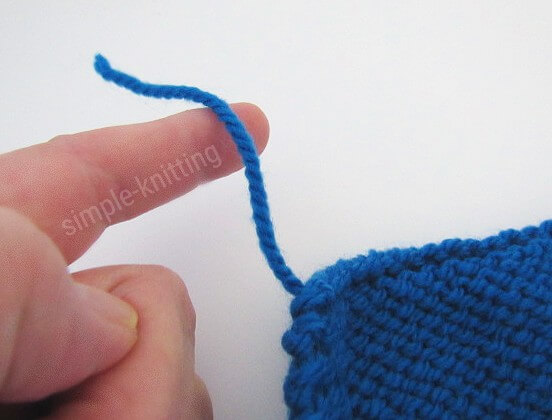 Knitting term yarn end(s)
Knitting term yarn end(s)The term yarn ends usually means all the extra ends that will need to be weaved into your knitting.
This yarn end in my photo is the end from my cast on and when I'm finished knitting I'll simply weave in the end(s)
If you are still looking for a knitting term and can't find it here be sure to check out my page on knitting abbreviations as well.
And as always if you ever need more help please click on that Contact Me button and I'll be right there to help you.
